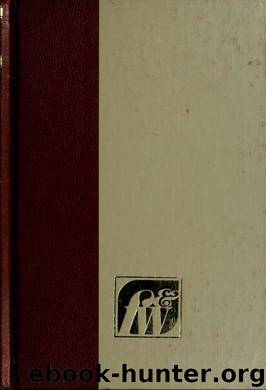Funk & Wagnalls new encyclopedia by Bram Leon L;Phillips Robert S;Dickey Norma H & Phillips Robert S & Dickey Norma H

Author:Bram, Leon L;Phillips, Robert S;Dickey, Norma H & Phillips, Robert S & Dickey, Norma H
Language: eng
Format: epub
Tags: Encyclopedias and dictionaries
Publisher: New York : Funk & Wagnalls
Published: 1979-03-02T16:00:00+00:00
LITTLETON, Sir Thomas (1407?-81), English jurist and writer, born in Frankley Manor House, Worcestershire. He was a well-known counsel at law in 1445 and served as recorder of Coventry in 1450. He became a justice of common pleas in 1466, and in 1475 Edward IV (q.v.), King of England, made him a Knight of the Bath. He is the author of the famous work on Tenures (1481?), a scientific classification of English land law, which formed an important part of legal education for three centuries. Written in legal French, the Tenures was the earliest work on English law ever printed, and was one of the first books to be printed in London. LITURGICAL HOURS. 5ee Breviary; Canonical Hours; Divine Office; Liturgy LITURGY, body of rites prescribed for formal public worship in Christian churches, particularly the prayers and ceremonies associated with the celebration of the Lord's Supper (q.v.). During the first three centuries of the Christian era, the rite of the Church was comparatively fluid, based on various accounts of the Last Supper. In about the 4th century the various traditions crystallized into four liturgies, the Antiochene or Greek, the Alexandrian, the Roman, and the Galilean, from which all others have been derived.
The Antiochene family of liturgies includes the Clementine liturgy of the Apostolic Constitutions (q.v.), which is no longer used; the Sy-riac liturgy of Saint James, used by the Jacobites and Syrian Uniates; the Greek liturgy of Saint James, used once a year at Jerusalem; the Syriac liturgy of the Maronites (q.v.); the Syriac liturgy used by the Nestorians (q.v.); the Malabar liturgy, used by the Saint Thomas Christians of India; the Byzantine liturgy, used in various languages by the Orthodox churches; and the Armenian liturgy, used by the Georgians and the Armenian Uniates. 5ee Armenian Church; Orthodox Church.
The Alexandrian liturgies include the Creek liturgy of Saint Mark, no longer used; the Coptic liturgy, which is used by the Copts (q.v.) in the Arab Republic of Egypt (formerly the United Arab Republic); and the Ethiopian liturgy, used by the Ethiopian Church.
The Roman liturgy is used almost universally by the Roman Catholic Church (q.v.). From it were derived various medieval liturgies, such as those of Sarum, Paris, Trier, and Cologne, which are no longer in use.
The Gallican liturgy was used in northwestern Europe from the 4th century; it was superseded in France around 800 by the Reman liturgy. From it developed the Ambrosian liturgy, now
used principally in the see of Milan; the Mozar-abic or Isidorian liturgy, which was the liturgy of the church in Spain from the 6th to the 12th centuries, and is now used only in Toledo and Salamanca; and the Celtic liturgy, which was superseded in the Celtic Church in the 7th century by the Roman liturgy. In the Roman Catholic Church the use of the vernacular in liturgies was to be substituted for Latin according to principles introduced during Vatican Council II (see Vatican Councils). Pope Paul VI (see under Paul) subsequently directed that vernacular forms of the Mass (q.
Download
This site does not store any files on its server. We only index and link to content provided by other sites. Please contact the content providers to delete copyright contents if any and email us, we'll remove relevant links or contents immediately.
| Administration & Medicine Economics | Allied Health Professions |
| Basic Sciences | Dentistry |
| History | Medical Informatics |
| Medicine | Nursing |
| Pharmacology | Psychology |
| Research | Veterinary Medicine |
Tuesdays with Morrie by Mitch Albom(4401)
Yoga Anatomy by Kaminoff Leslie(4100)
Science and Development of Muscle Hypertrophy by Brad Schoenfeld(3971)
Bodyweight Strength Training: 12 Weeks to Build Muscle and Burn Fat by Jay Cardiello(3779)
Introduction to Kinesiology by Shirl J. Hoffman(3626)
How Music Works by David Byrne(2964)
Sapiens and Homo Deus by Yuval Noah Harari(2843)
The Plant Paradox by Dr. Steven R. Gundry M.D(2425)
Insomniac City by Bill Hayes(2396)
Churchill by Paul Johnson(2362)
Coroner's Journal by Louis Cataldie(2358)
The Chimp Paradox by Peters Dr Steve(2224)
Hashimoto's Protocol by Izabella Wentz PharmD(2200)
The Universe Inside You by Brian Clegg(2048)
The Immune System Recovery Plan by Susan Blum(1965)
Don't Look Behind You by Lois Duncan(1915)
The Hot Zone by Richard Preston(1910)
Endure by Alex Hutchinson(1872)
Woman: An Intimate Geography by Natalie Angier(1841)
